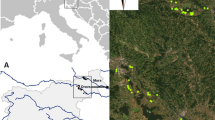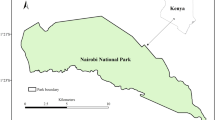Abstract
Prevention is the most effective way of mitigating the negative impacts of exotic species invasions on biodiversity. Preventative measures include inhibiting the further dispersal and recruitment of established invasive species. We expect coffee production in agroforestry systems to reduce the recruitment of exotic species relative to monoculture stands because intercropped trees function as environmental filters that select for individuals with traits such as shade tolerance. If ecologically similar species are also closely related phylogenetically, such environmental filters should reduce phylogenetic diversity, supporting the coexistence of closely related species. Here, we test whether the taxonomic and phylogenetic diversity of native and exotic species in agroforestry systems is lower than in monocultures. We sampled the understory in 180 plots distributed in both habitats in three study sites within the Araponga municipality, Brazil, and measured understory light availability. Phylogenetic diversity was calculated as the net relatedness index (NRI) and the nearest taxon index (NTI). Understory light availability was lower in agroforestry systems. Of the 48 species found, 25 occurred in agroforestry systems, three of which were exotics. Forty-two species were found in monoculture stands (including 13 exotics). As expected, NRI and NTI indicated lower phylogenetic diversity in agroforestry systems than in monoculture stands. Agroforestry systems provide less favorable habitats for exotic species, filtering them from the understory. The mechanisms that select against exotic species remain unknown; however, shading might exclude predominantly heliophytic exotic species from the agricultural matrix. Therefore, agroforestry systems may function as buffer zones preventing invasion into sensitive ecosystems.





Similar content being viewed by others
References
Anderson RC, Loucks OL, Swain AM (1969) Herbaceous response to canopy Cover, light intensity, and through fall precipitation in coniferous forests. Ecology 50:255–263
Angiosperm Phylogeny Group III (2009) An update of the Angiosperm Phylogeny Group classification for the orders and families of flowering plants: APG III. Bot J Linn Soc 161:105–121
Baker HG (1974) The evolution of weeds. Annu Rev Ecol Syst 5:1–24
Baraloto C, Hardy OJ, Paine CET, Dexter KG, Cruaud C et al (2012) Using functional traits and phylogenetic trees to examine the assembly of tropical tree communities. J Ecol 100:690–701
Bhagwat SA, Willis KJ, Birks HJ, Whittaker RJ (2008) Agroforestry: a refuge for tropical biodiversity? Trends Ecol Evol 23:261–267
Cadotte MW, Borer ET, Seabloom EW, Cavender-Bares J, Harpole WS, Cleland E, Davies KF (2010) Phylogenetic patterns differ for native and exotic plant communities across a richness gradient in Northern California. Divers Distrib 16:892–901
Cavender-Bares J, Ackerly DD, Baum DA, Bazzaz FA (2004) Phylogenetic overdispersion in Floridian oak communities. Am Nat 163:823–843
Cavender-Bares J, Keen A, Miles B (2006) Phylogenetic structure of Floridian plant communities depends on taxonomic and spatial scale. Ecology 87:S109–S122
Cavender-Bares J, Kozak KH, Fine PVA, Kembel SW (2009) The merging of community ecology and phylogenetic biology. Ecol Lett 12:693–715. doi:10.1111/j.1461-0248.2009.01314.x
Chandrasekaran S, Swamy P (2002) Biomass, litterfall and aboveground net primary productivity of herbaceous communities in varied ecosystems at Kodayar in the western ghats of Tamil Nadu. Agric Ecosyst Environ 88:61–71
Chapin FS III, Zavaleta ES, Eviner VT, Naylor RL, Vitousek PM et al (2000) Consequences of changing biodiversity. Nature 405:234–242
Cianciaruso MV, Silva IA, Batalha MA, Gaston KJ, Petchey OL (2012) The influence of fire on phylogenetic and functional structure of woody savannas: moving from species to individuals. Perspect Plant Ecol Evol Syst 14:205–216. doi:10.1016/j.ppees.2011.11.004
Costa JNMN, Durigan G (2010) Leucaena leucocephala (Lam.) de Wit (Fabaceae): invasora ou ruderal? Rev Árvore 34:825–833
Cullen L, Lima JF, Beltrame TP (2004) Agroforestry in buffer zones and stepping stones: tools for the conservation of fragmented landscapes in the Brazilian Atlantic forest. In: Schroth G, Fonseca GAB, Harvey CA, Vasconcelos HL, Gascon C, Izac AMN (eds) Agroforestry and biodiversity conservation in tropical landscapes. Islandpress, Washington, pp 415–430
Díaz S, Hodgson JG, Thompson K, Cabido M, Cornelissen JHC et al (2004) The plant traits that drive ecosystems: evidence from three continents. J Veg Sci 15:295–304
Elton CS (2000–1958) The ecology of invasions by animals and plants. University of Chicago Press, Chicago
Fernandes JM (2007) Taxonomia e etnobotânica de Leguminosae Adans. em fragmentos florestais e sistemas agroflorestais na Zona da Mata Mineira. Master thesis, Federal University of Viçosa, Viçosa
Fine PVA (2002) The invasibility of tropical forests by exotic plants. J Trop Ecol 18:687–705
Forzza RC (coord) (2014) Lista de Espécies da Flora do Brasil. http://www.floradobrasil.jbrj.gov.br/2012/. Retrieved Mar 2014
Frazer GW, Canham CD, Lertzman KP (1999) Gap light analyzer (GLA), Version 2.0: imaging software to extract canopy structure and gap light transmission indices from true-colour fisheye photographs, users manual and program documentation. Simon Fraser University, Burnaby, and the Institute of Ecosystem Studies, Millbrook
Gastauer M, Meira-Neto JAA (2013) Avoiding inaccuracies in tree calibration and phylogenetic community analysis using Phylocom 4.2. Ecol Inform 15:85–90
Gastauer M, Meira-Neto JAA (2014) Interactions, environmental sorting and chance : phylostructure of a tropical forest assembly. Folia Geobot. doi:10.1007/s12224-013-9181-1
Gilbert B, Levine JM (2013) Plant invasions and extinction debts. PNAS 110:1744–1749. doi:10.1073/pnas.1212375110
Green PT, Lake PS, O’Dowd DJ (2004) Resistance of Island rainforest to invasion by Alien plants: influence of microhabitat and herbivory on seedling performance. Biol Invasions 61:1–9
Harvey CA, Villalobos JG (2007) Agroforestry systems conserve species-rich but modified assemblages of tropical birds and bats. Biodiv Conserv 16:2257–2292
Jose S (2009) Agroforestry for ecosystem services and environmental benefits: an overview. Agrofor Syst 76:1–10
Jose S (2012) Agroforestry for conserving and enhancing biodiversity. Agrofor Syst 85:1–8
Jose S, Bardhan S (2012) Agroforestry for biomass production and carbon sequestration. Agrofor Syst 86:105–112
Kehlenbeck K, Kindt R, Sinclair FL, Simons AJ, Jamnadass R (2011) Exotic tree species displace indigenous ones on farms at intermediate altitudes around Mount Kenya. Agrofor Syst 83:133–147
MacArthur RH (1970) Species packing and competitive equilibrium for many species. Theoret Popul Biol 1:1–11
MacArthur RH (1972) Geographical ecology. Harper and Row, New York
MacArthur RH, Levins R (1967) The limiting similarity, convergence and divergence of coexisting species. Am Nat 101:377–385
Mack RN (1996) Predicting the identity and fate of plant invaders: emergent and emerging approaches. Biol Conserv 78:107–121
Mack RN, D’Antonio MC (1998) Impacts of biological invasions on disturbance regimes. Trends Ecol Evol 13:195–198
Mack RN, Simberloff D, Lonsdale WM, Evans H, Clout M, Bazzaz FA (2000) Biotic invasions: causes, epidemiology, global consequences, and control. Ecol Appl 10:689–710
Martin PH, Canham CD, Marks PL (2009) Why forests appear resistant to exotic plant invasions : intentional introductions, stand dynamics, and the role of shade tolerance. Front Ecol Environ 7:142–149
Martins CR, Leite LL, Haridasan M (2004) Capim-gordura (Melinis minutiflora P. Beauv.), uma gramínea exótica que compromete a recuperação de áreas degradadas em unidades de conservação. Rev Árvore 28:739–747
Millennium Ecosystem Assessment (2005) Biodiversity: what is it, where is it, and why is it important? In: Ecosystems and human well-being: biodiversity synthesis. Resources Institute, Washington DC, pp 18–29
Missouri Botanical Garden (2013) http://www.tropicos.org. Accessed 9 Dec 2013
Montagnini F, Jordan CF (2005) Tropical forest ecology. Springer, Heiderlberg
Nath CD, Pélisser R, Ramesh BR, Garcia C (2011) Promoting native trees in shade coffee plantations of southern India: comparison of growth rates with the exotic Grevillea robusta. Agrofor Syst 83:107–119
Nobel JR, Dirzo R (1997) Forests as human-dominated ecosystems. Science 277:522–525
Oliveira ACC (2013) Sistemas agroflorestais com café: fixação e neutralização de carbono e outros serviços ecossistêmicos. Master thesis, Federal University of Viçosa, Viçosa
Peel MC, Finlayson BL, McMahon TA (2007) Updated world map of the Koppen-Geiger climate classification. Hydrol Earth Syst Sci 11:1633–1644
Perfecto I, Vandermeer J (2010) The agroecological matrix as alternative to the land-sparing/agriculture intensification model. Proc Natl Acad Sci USA 107:5786–5791
Perrings C, Williamson M, Dalmazzone S (2000) The economics of biological invasions. Edward Elgar Publishing, Cheltenham
Perrings C, Williamson M, Barbier EB, Delfino D, Dalmazzone S et al (2002) Biological invasion risks and the public good: an economic perspective. Conserv Ecol 6(1):1
Pivello VR (2005) Invasões biológicas no cerrado brasileiro: efeitos da introdução de espécies exóticassobre a biodiversidade. Ecologia. http://www.ecologia.info/cerrado.htm. Accessed 22 Aug 2012
R Core Team (2014) R: a language and environment for statistical computing. R Foundation for Statistical Computing, Vienna. http://www.R-project.org/
Sanders NJ, Gotelli NJ, Heller NE, Gordon DM (2003) Community disassembly by an invasive species. PNAS 100:2474–2477. doi:10.1073/pnas.0437913100
Schroth G, Fonseca GAB, Harvey CA, Vasconcelos HL, Gascon C, Izac AMN (2004) The role of agroforestry in biodiversity conservation in tropical landscapes. In: Schroth G, Fonseca GAB, Harvey CA, Vasconcelos HL, Gascon C, Izac AMN (eds) Agroforestry and biodiversity conservation in tropical landscapes. Island press, Washington, pp 1–12
Silva WM Jr, Melo FR, Moreira LS, Barbosa EF, Meira-Neto JAA (2009) Structure of Brazilian Atlantic forests with occurrence of the woolly spider monkey (Brachyteles hypoxanthus). Ecol Res 25:25–32
Simberloff DS (1970) Taxonomic diversity of island biotas. Evolution 24:23–47. doi:10.2307/2406712
Siqueira LC (2008) Levantamento Florístico e Etnobotânico do estrato Arbóreo em Sistemas Naturais e Agroflorestais em Araponga, Minas Gerais. Master thesis, Federal University of Viçosa, Viçosa
Souza HN, Goede RGN, Brussaard L, Cardoso IM, Duarte EMG, Fernandes BA et al (2012) Protective shade, tree diversity and soil properties in coffee agroforestry systems in the Atlantic Rainforest biome. Agric Ecosyst Environ 146:179–196
Swenson NG, Enquist BJ (2009) Opposing assembly mechanisms in a Neotropical dry forest: implications for phylogenetic and functional community ecology. Ecology 90:2161–2170
Uezu A, Beyer DD, Metzger JP (2008) Can agroforest woodlots work as stepping stones for birds in the Atlantic forest region? Biodiv Conserv 17:1907–1922
Valiente-Banuet A, Verdú M (2007) Facilitation can increase the phylogenetic diversity of plant communities. Ecol Lett 10:1029–1036
van der Valk AG (1981) Succession in wetlands: a gleasonian appraoch. Ecology 62:688–696. doi:10.2307/1937737
Veloso HP, Rangel Filho ALR, Lima JCA (1991) Classificação da vegetação brasileira, adaptada a um sistema universal. IBGE, Rio de Janeiro
Webb CO, Donoghue MJ (2005) Phylomatic: tree assembly for applied phylogenetics. Mol Ecol Notes 5:181–183
Webb CO, Ackerly DB, McPeek MA, Donoghue MJ (2002) Phylogenies and community ecology. Annu Rev Ecol Syst 33:475–505
Weiher E, Keddy PA (1995) Assembly rules, null models, and trait dispersion: new questions from old patterns. Oikos 74:159–164
Williams M (1999) Invasions. Ecography 22:5–12
Wittenberg R, Cock MJW (2001) Invasive Alien species: a toolkit of best prevention and management practices. CAB International, Wallingford
Zenni RD, Ziller SR (2011) An overview of invasive plants in Brazil. Rev Bras Bot 34:431–446
Ziller SRA (2000) Estepe Gramíneo-Lenhosa no Segundo planalto do Paraná: diagnóstico ambiental com enfoque à contaminação biológica. Ph.D. thesis, Federal Univiersity of Paraná, Curitiba
Acknowledgments
We are grateful to the Floresta-Escola Environmental Science Center, SECTES-MG, CNPq, FAPEMIG and CAPES for Grants and scholarships.
Author information
Authors and Affiliations
Corresponding author
Rights and permissions
About this article
Cite this article
Ramos, N.C., Gastauer, M., de Almeida Campos Cordeiro, A. et al. Environmental filtering of agroforestry systems reduces the risk of biological invasion. Agroforest Syst 89, 279–289 (2015). https://doi.org/10.1007/s10457-014-9765-7
Received:
Accepted:
Published:
Issue Date:
DOI: https://doi.org/10.1007/s10457-014-9765-7




